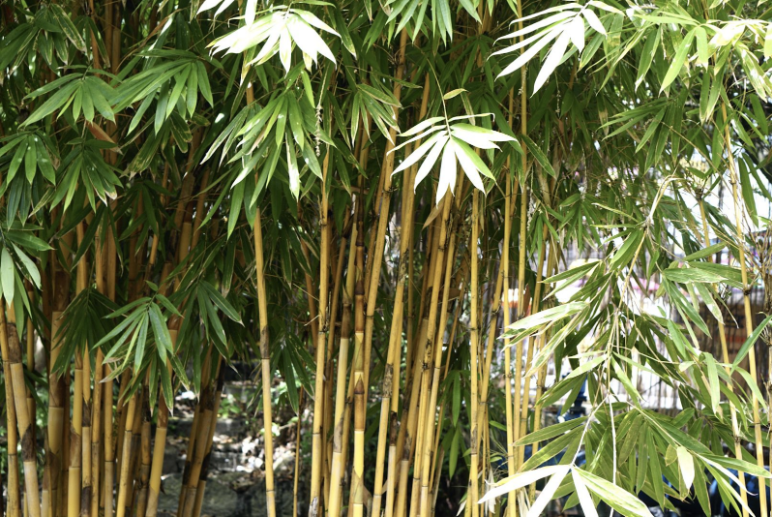Bamboo as a sustainable biomass and possible source of biofuel
There are many different types of biomasses, or renewable organic materials that can produce energy, ranging from animal waste to garbage; bamboo has the potential to be a revolutionary one.
The natural characteristics of bamboo make it convenient and accessible as a biofuel. Since bamboo is a type of grass, it grows very quickly and renews itself without needing to be plowed or sowed (2). While some forms of bioenergy require specific land and water for production, bamboo can grow on degraded land, land that has lost its natural productivity due to pollution and overfarming, or with other crops. This makes growing bamboo uniquely sustainable and accessible (3). In a region with ideal growing conditions, bamboo’s maximum yield is approximately 50,000 kilograms per hectare annually (2). Bamboo also has a low ash content, a low alkali index, and a low moisture content compared to other plants, which are all useful qualities for biofuel sources (2).
There are several ways to turn bamboo into a biofuel, but thermochemical conversion and biochemical conversion are the two most common methods (1). Thermochemical conversion uses heat to turn bamboo into fuel, while biochemical conversion uses a bacteria or fungus to turn bamboo into fuel (3).

Thermochemical conversion could take the forms of direct combustion, gasification, or pyrolysis liquefaction. Combustion is the process of combining a fuel that contains hydrogen and carbon, such as bamboo, with oxygen to create water, carbon dioxide, and heat. Through direct combustion, dry bamboo is used as firewood to generate heat at a local and industrial scale (3).
Occurring at temperatures between 750 and 1200 degrees Celsius and with little oxygen, the gasification process creates gaseous fuel from solid fuel (1). The gasification process is a combination of other methods, including pyrolysis and combustion (1). Gasification produces syngas, a mixture of combustible gasses like carbon monoxide, methane, and hydrogen and incombustible gasses like carbon dioxide and nitrogen (4). Gasification is more efficient than combustion because it has better fuel recovery (1).
Lastly, pyrolysis is the process of thermal degradation: polymers of bamboo go through chemical changes at high temperatures without oxygen (1). Pyrolysis produces charcoal, oils, tar, and syngas (1). Different temperatures produce different products: at 350-400 degrees Celsius charcoal and syngas are produced, while at 500-600 degrees Celsius, condensable oils are produced (4).
On the other hand, biochemical conversion uses different strains of microorganisms, bacteria or fungi, to produce biofuel products; it does so through two main processes: fermentation and anaerobic digestion. Fermentation is the decomposition of sugar or starch by bacteria and yeast, producing ethanol (4). Anaerobic digestion is the degradation of organic matter in the absence of oxygen, producing methane and carbon dioxide (4).
Biomasses such as bamboo are more environmentally-friendly sources of renewable energy compared to fossil fuels. Fossil fuels are easy to store, use and transport; however, they pollute the environment and are limited resources. Although bamboo is a biomass newly used at a large scale, it is already used extensively for fuel in India, China, and Brazil (3).
Bibliography
- an Ha Truong, Thi My Anh Le. Overview of bamboo biomass for energy production. 2014. Ffhalshs01100209f
- “bamboo for Fuel and Energy: Another Green Solution.” Bambu Batu, 1 Feb. 2021, https://bambubatu.com/bamboo-for-fuel-and-energy/.
- Sharma, Roshan, et al. bamboo as an Alternative Bioenergy Crop and Powerful Ally for Land Restoration in Indonesia. School of Global, Urban and Social Studies at RMIT University, November 23, 2018
- “Bioenergy Production from bamboo: Potential Source from Malaysia’s Perspective.” NC State, https://bioresources.cnr.ncsu.edu/resources/bioenergy-production-from-bamboo-potential-source-from-malaysias-perspective/#:~:text=other%20woody%20biomass.-,bamboo%20can%20be%20used%20as%20an%20energy%20source%20by%20converting,and%20stable%20supply%20is%20required.
